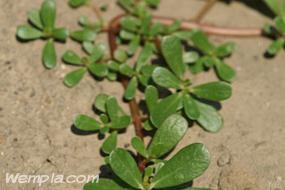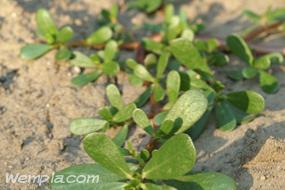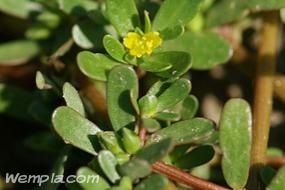Purslane
Portulaca oleracea
Portulacaceae
Image Provider(s): netherbarium
Edible Uses
 Leaf
Leaf
Leaves and stems can be used together. It has a salty, sour taste and slightly mucilaginous quality. It can consumed fresh in salads, or cooked as a side dish or soup. It fits in almost any recipe. It has a consistency-improving effect as well, it thickens the soups and sauces. Eating purslane has a tradition in many countries of the world.
 Flower buds
Flower buds
Bulb can be used together with leaves and stems. Separately harvested, it may be preserved in vinegar and salty water to get a capers-like food.
Medicinal Uses
It is a mucilaginous plant, but hungarian folk medicine does not use as a herb.
Main Characteristics
10-30 cm long herbaceous, annual plant. Stems are round, juicy, red-colored and densely branched. Leaves are obovovate and succulents. Flowers are very small, yellow colored, they opens in the morning. The fruit is a capsule, with tiny black seeds in it.
Habitats
Weed associations
Harvesting aid
 Leaf
Leaf
August, July, November, October, September
The leaves and stems can be gathered together. It is a pioneer plant living also in contaminated environment, so pay attention to gather only from clean area.
 Flower buds
Flower buds
August, July, September
The buds can be collected together or separately from the leaves and stems. They are relatively large.
Confusion with other plants
This plant is easy to identify.
Description
Life Span: annual
Size: 10 cm - 30 cm
Bloom time: August,
July,
September,
Alternative common name(s):
- Verdolaga
- Pigweed
- Little hogweed
- Red root
- Pursley
Flower
Inflorescence type: Head
Flower Colour: Yellow 


Flower shape: 5 petaled
Stem
Leaf
Foliage type: Opposite and decussate
Foliage texture: Juicy
Leaf shape: Obovate
Leaf margin: Entire
Leaf type: Simple
Fruit
Fruit Category: Seed 


Fruit type: Capsule 





